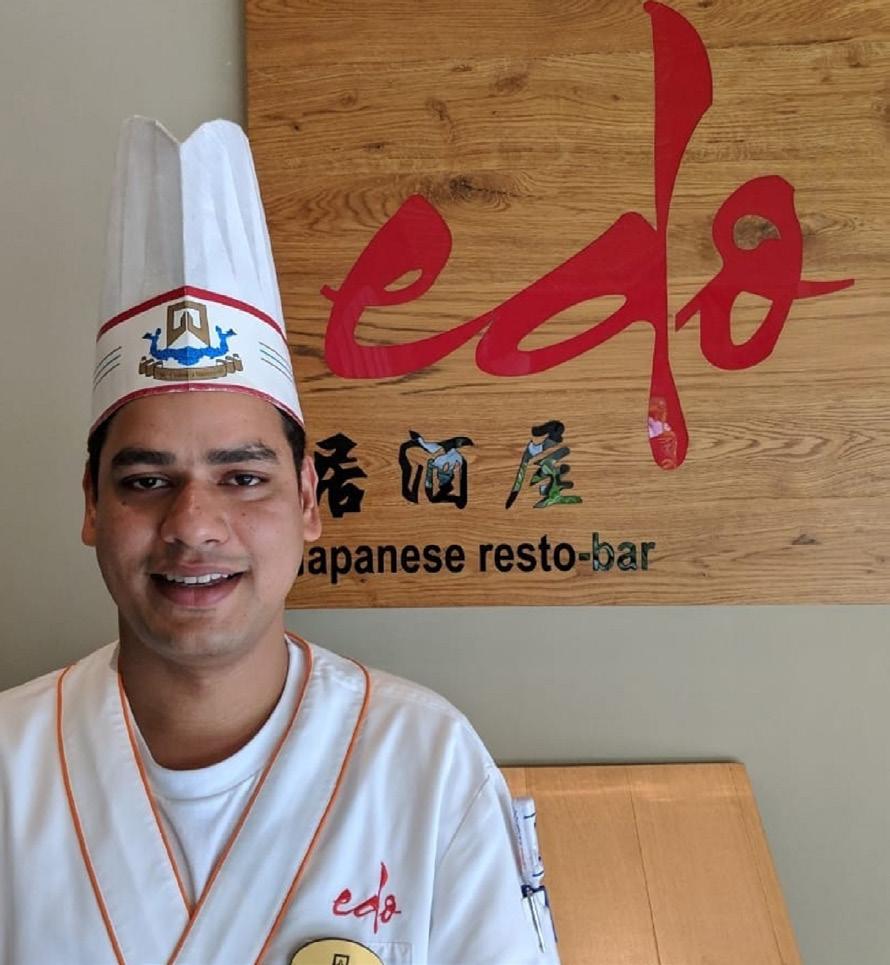
6 minute read
Divine Plates
DIVINE PLATES DIVINE PLATES Spurred on by foodies, A selection of Japanese temple foods served at Edo, the Japanese specialty restaurant at ITC Gardenia in Bengaluru high-end restaurants in India are beginning to serve traditional temple fare
BINDU GOPAL RAO
Food served as prasad in temples may seem commonplace in India. However, across the country there is a whole new spectrum of cuisine that is as mind boggling as it is diverse. Every kind comes with a touch of spirituality, which adds to its mysticism. In India, temple food has always held a special place in the hearts of the people. Food served as prasad in temples may seem commonplace in India. HISTORICAL CONNECT
K.T. Acharya in his book “The Illustrated Foods of India,” says, “It is usual in the Hindu temple to prepare foods that are first offered to the deities and left in their presence for a while to satiate this spiritual hunger. Thereafter, the food becomes a sanctified prasad. which is distributed or even sold to the assembled devotees. In South India the Padmanabhaswami temple, in Thiruvanthapuram has a special avial that uses traditional vegetables, fresh coconut and coconut oil and no mustard seeds. The Ganesha temples of Kerala have the unni-appam, which are spongy brown fried pieces, made of a mélange of rice powder, banana, jackfruit and jaggery. The Muruga temple of Palani Hills has its own panchamrita of crystal sugar, honey, ghee cardamom and fruits (bananas, dates and raisins), which does not go rancid, even after six weeks. The great Vishnu temple of Devarajaswami in Kanchipuram has a prasad of a giant idli, weighing a kilo and a half (3.3 pounds). This is spiced with pepper, jeera, ginger and asafoetida fermented with curd and then steamed. The Vishnu temple at Srimushnam has a confection prepared from the sweet root korai, which is dear to Varaha, the boar incarnation of Lord Vishnu.”
Of course, most people know of the famed Tirupati laddu which is made every day in the inner kitchen by 30 cooks, who use tons of urad dal, sugar, ghee, raisins, cashew nuts and cardamom to make it. At the Dharmasthala temple in Karnataka food is served to several thousands of people every day. One of the most elaborate preparations of temple food is at the Jagannath temple in Puri, Odisha where every day, thousands of persons manning 750 stoves and ovens, turn out hundreds of varieties of dishes.
“Using rice and wheat, and their flours and grits, urad dal, indigenious vegetables, jaggery and spices with cow ghee as the cooking medium, the Gods are served ritually five times a day,” notes Acharya.

Sudha Tilak, author of “Temple Tales,” a book on the many unique aspects related to the temples of India, including details about its food
DIVERSITY IN DIVINITY
Sudha G Tilak, author of “Temple Tales,” a book on the many unique aspects related to the temples of India, including details about its food shares some interesting experiences:
“The Annapurna temple in Varanasi is the story of how food is nourishment for humans and good life in India. The mahaprasad in the Jagannath temple in Odisha is a huge catering operation by the temple kitchen; Chappan bhog consists of 56 food items offered in temples to the god Krishna in Uttar Pradesh. The women of an entire village gather to cook sweet rice at the Attukal Bhagawathy temple in Kerala, and some food historians say the ubiquitous masala dosa had its origins in the Udupi Sri Krishna temple in South India.”
Often there are colorful legends and myths associated with the temples and reasons why certain foods are offered.
SPIRITUAL CONNECT
Interestingly, apart from India, temple foods are also popular in countries like Japan, Korea, Vietnam and China.
Nimai Pandit, founder of Gopal Farm, a 120-acre farm in New Paltz, NY, in the Hudson Valley, has plans to open a restaurant next year in collaboration with Chef Hari Nayak focusing on temple foods.
“I was trained at ISKON’s Hare Krishna temple in Bengaluru,”

Pandit says. “The Vaishnavas are known to offer food to the gods that is then distributed as prasad that is a way of purifying the food. In New York, in fact we have a Michelin star restaurant that specializes in Japanese temple food called Kajitsu that serves Shojin Ryori menu, a vegetarian menu originally served by Japanese Buddhist monks.” Shojin Ryori cuisine is a combination of various flavors and simple processes which makes it so unique. The most simplistic form of Shojin Ryori is the traditional Buddhist cuisine that spread through China in the sixth century. Like the Saatvik concept of cooking in India, temple food in Japan is largely driven by the idea of eating local and seasonal produce.
Edo, the Japanese specialty restaurant at ITC Gardenia in Bengaluru, hosted a food promotion event to break the myth that Japanese cuisine is mainly non vegetarian. The master chefs at ITC Gardenia dug deep into this historic cuisine to bring out the authentic flavors. Temple cuisine is dominated by soya products. It is based on the concept of nonviolence, i.e. ahimsa and includes small portions of seaweed and underwater mushrooms such as mozuku, koyadofu, aburagae and yubaand. While there is no set rule,

Nimai Pandit, founder of Gopal Farm, a 120-acre farm in New Paltz, NY, in the Hudson Valley

Amit Patra, masterchef, Edo, ITC Gardenia Bengaluru
mindful eating is what makes consumption very different. There are various advantages of this cuisine, such as gaining focus, losing weight and clearing one’s mind to strengthen concentration,” says Amit Patra, masterchef at the Edo Restaurant & Bar, ITC Gardenia.
SEASONAL FACTOR

While eating seasonal may be in vogue in the culinary circles, Hindu temple prasad or food offerings are unique as they have always used local and seasonal produce. Varr in Rishikesh is a new restaurant that offers a thousand-year-old history of Indian temples on a plate.
The service sequence, audio visuals and small rituals will ensure customers gain a new respect for Indian culture, says Tarun Gulati, director of the Himalayan Hotels & DJUBO Hotel Tech Suite , pointing out that the food relies on healthy ingredients, both locally sourced and delivered by select vendors across India.
Menu planning and selection of ingredients for Varr are based on principles and wisdom of Ayurveda on the one hand and derived from ages of practices and rituals across Indian temples on the other. I addition, the dishes are topped up with infusions of immunity boosting ingredients such as cinnamon, curry leaves, tulsi, ashwagandha, giloy, triphala, gooseberry, ginger, nutmeg and turmeric.
According to Anushruti RK, a food writer and recipe creator at Divine Taste, “The food cooked in the temples of India (with the exception of a few Shiva and Kali temples) are based on Ayurvedic principles of Sattvic philosophy, making it good for the body, mind and soul. Food cooked in the temples of India is made with fresh ingredients which are locally sourced with recipes dating back to hundreds of years making it delicious and healthy at the same time.”
And as the pandemic continues, it is perhaps time we reconsider our diets. After all, the lessons of the past can serve us well in the present and the future.
Anushruti RK, a food writer and recipe creator at Divine Taste










